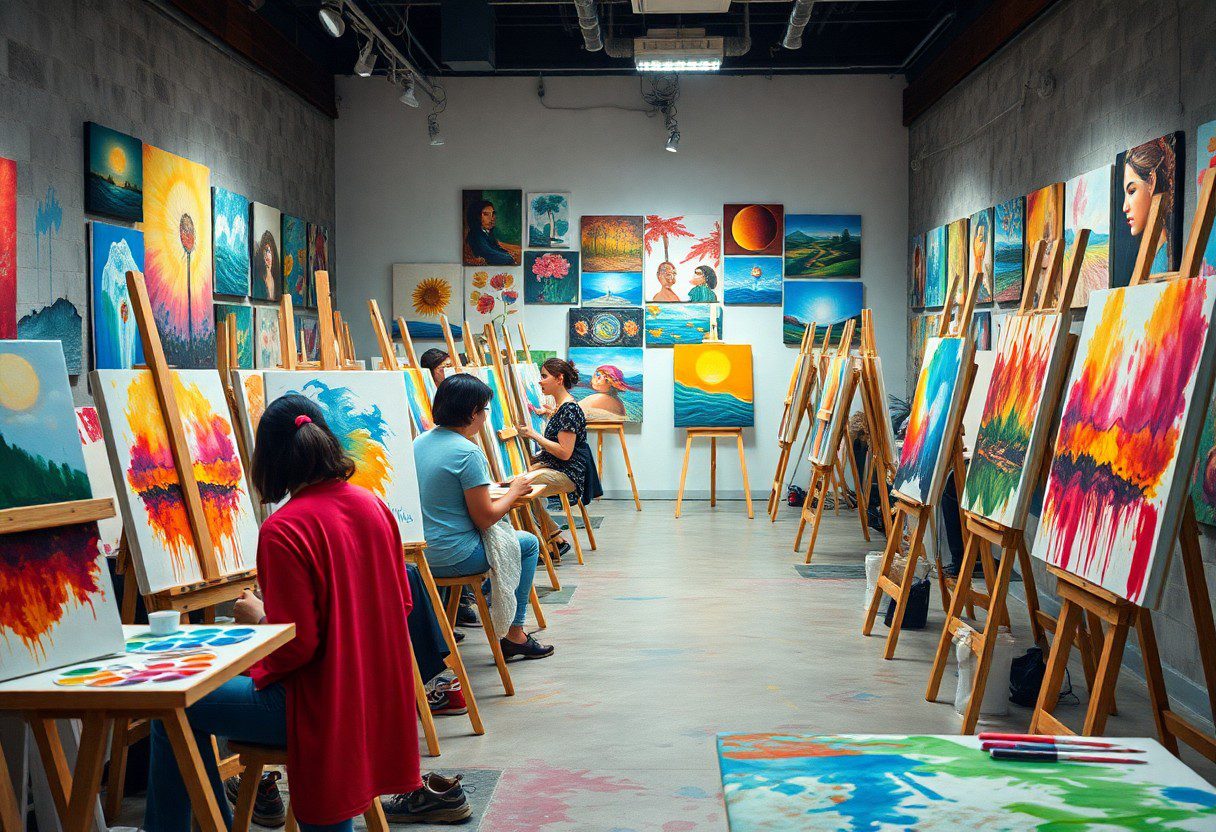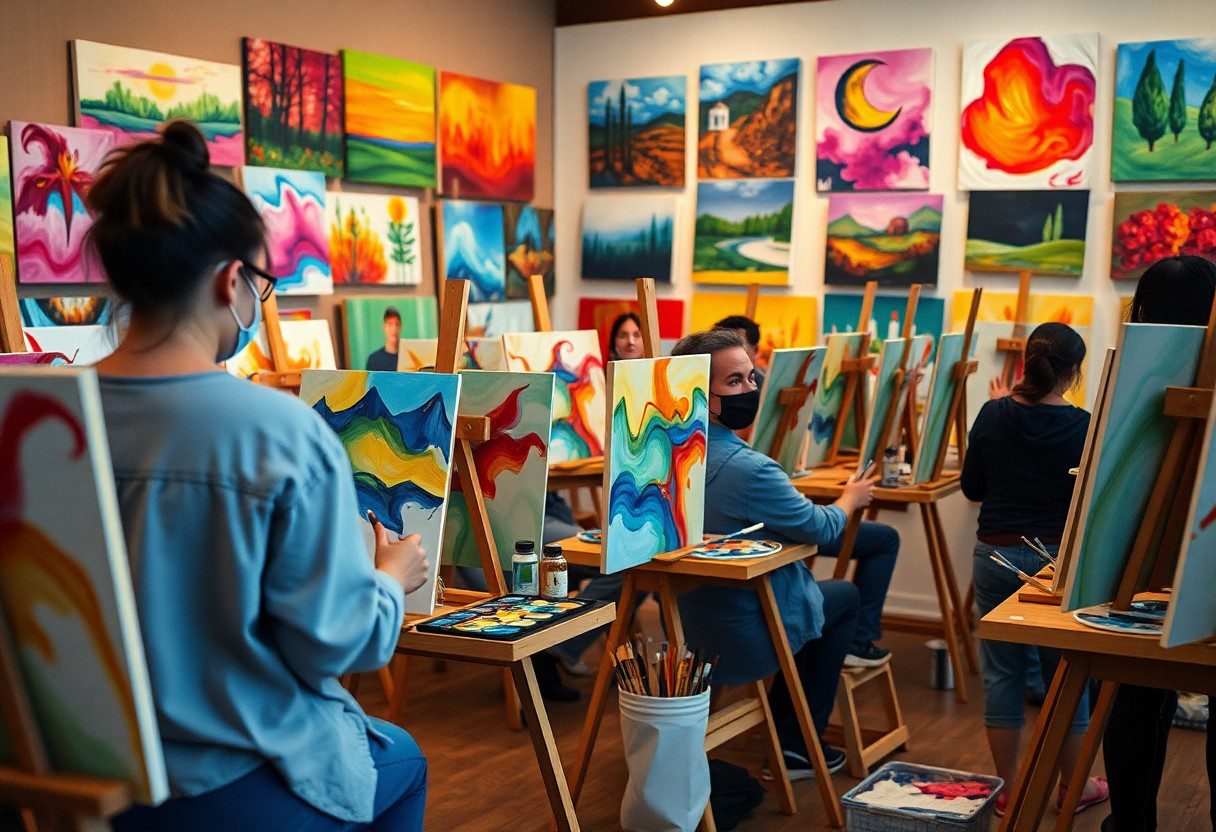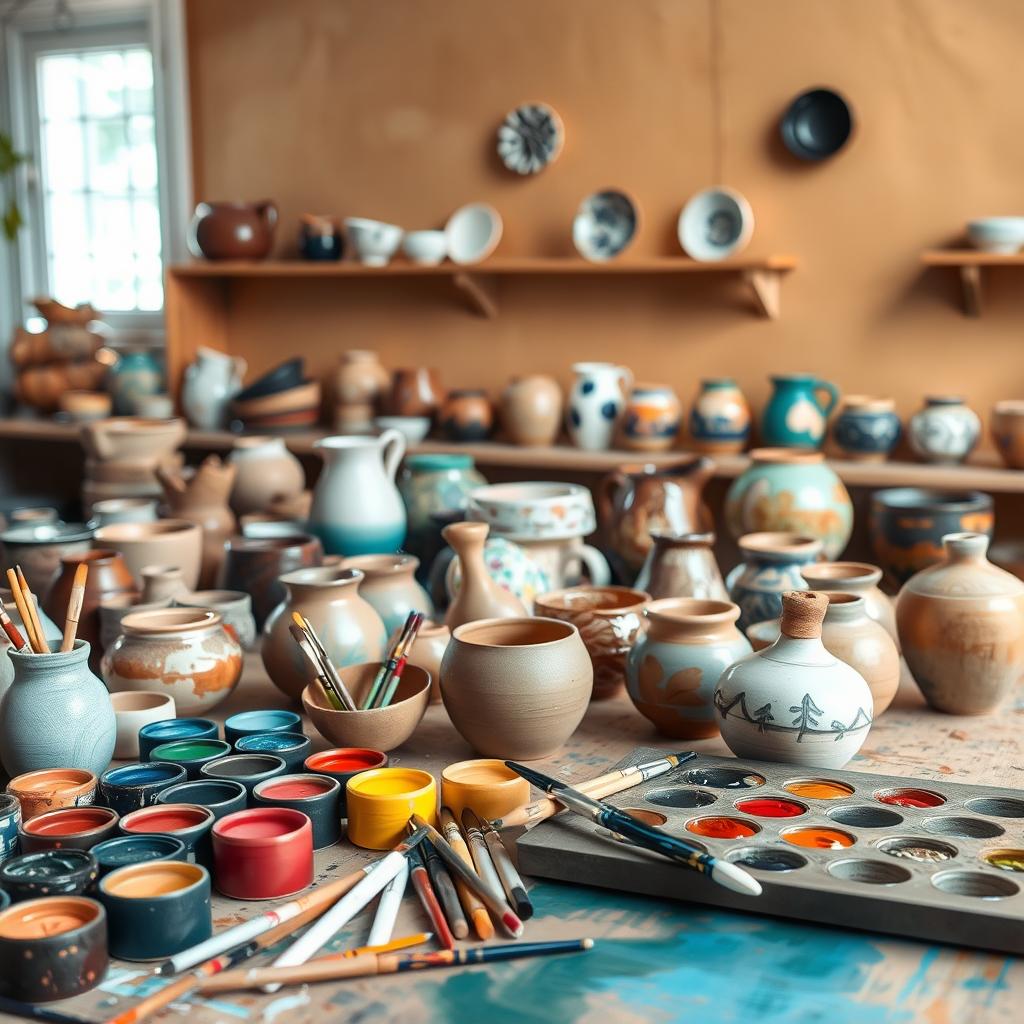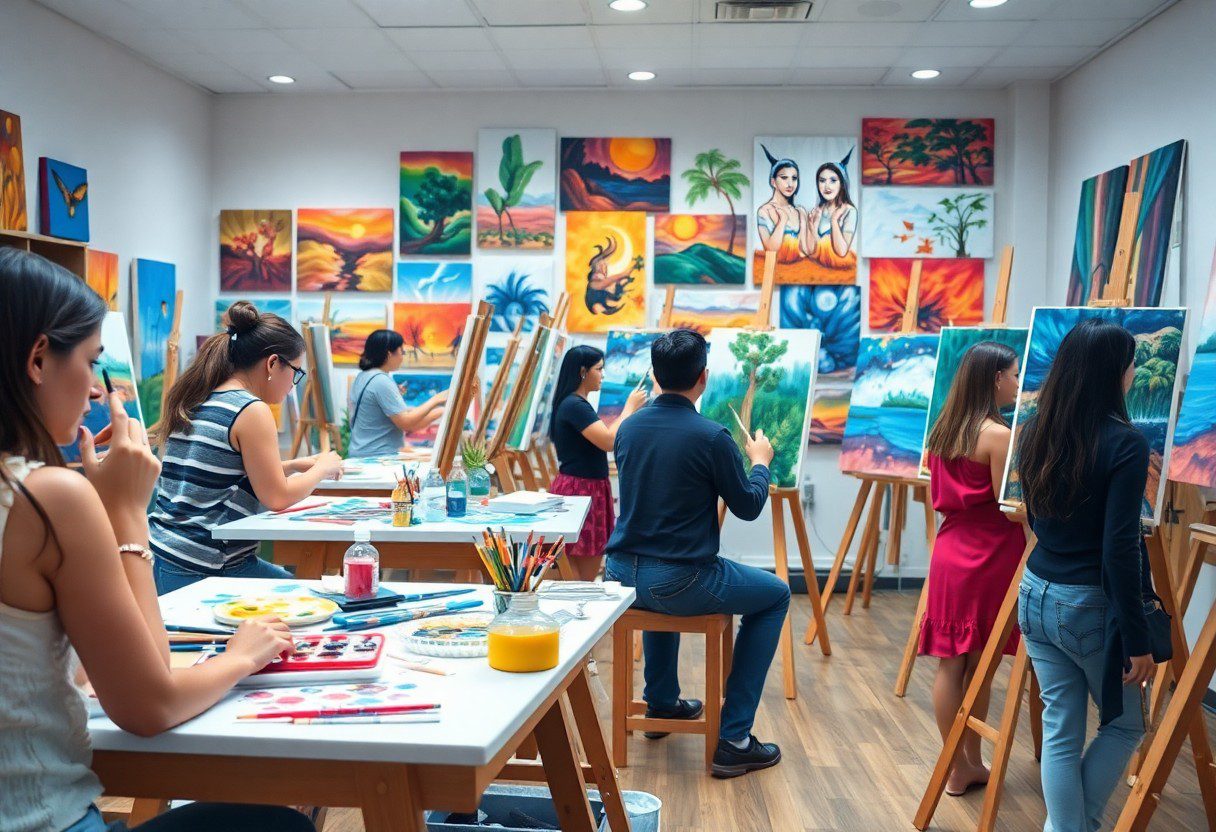Over the next few minutes, you will explore everything you need to know to look into the vibrant world of acrylic painting. This guide will equip you with the imperative workshop insights and techniques that are perfect for your artistic journey. Whether you’re a complete novice or looking to refine your skills, you’ll find valuable information on selecting the right supplies, mastering basic techniques, and enhancing your creativity. Let’s begin on this colorful adventure together and unleash your artistic potential!
Types of Acrylic Painting Techniques
A variety of acrylic painting techniques can elevate your skills and creativity in workshops. Understanding these techniques is imperative for both beginners and seasoned artists. Explore this list of methods:
| Wet-on-wet | Blending colors directly on the canvas while still wet |
| Dry brushing | Using a brush with minimal paint for textured effects |
| Glazing | Applying thin layers of transparent paint to build depth |
| Stippling | Creating images using small dots for added details |
| Pouring | Manipulating liquid paint on canvas for abstract designs |
Perceiving these techniques can help you select the best approach for your art style.
Brush Techniques
One of the versatile methods, brush techniques offer a range of textures and styles for your paintings. Using different brush sizes and shapes, you can create everything from fine details to broad strokes. Familiarizing yourself with your brushes will help you find what works best for your artistic expression.
Palette Knife Techniques
Techniques involving a palette knife allow for unique textural effects that brushes can’t achieve. You can apply, scrape, and mix paint in dynamic ways, creating stunning layers and patterns. It’s an excellent technique for abstract creations or adding impasto effects.
The use of a palette knife can lead to dramatic results in your artwork. By effortlessly blending or layering colors, you can achieve a sense of depth. It’s imperative to be cautious, as the sharp edges of the knife can be dangerous. However, embracing this technique can reveal your artistic potential and enhance your painting experience, making your work uniquely yours.
Step-by-Step Guide to Starting Your First Acrylic Painting
There’s nothing quite like the feeling of creating your first acrylic painting. This step-by-step guide will help you navigate through the process confidently, ensuring a successful and enjoyable experience.
| Step | Description |
| 1 | Gather your materials and set up your workspace. |
| 2 | Sketch your desired design on canvas. |
| 3 | Start with a base coat of paint. |
| 4 | Add layers and details progressively. |
| 5 | Finish by adding any final touches and letting it dry. |
Materials Needed
Little time spent gathering the right supplies can dramatically affect your painting experience. For a beginner, you’ll need acrylic paints, a sturdy canvas, various brushes, water for rinsing, and a palette for mixing colors. Additional items like a palette knife, paper towels, and easel can offer further assistance as you work.
Basic Painting Steps
Guide yourself through the painting process by following these straightforward steps. Start with choosing your color palette and mixing your paints. Then, apply your first coat using broader brushes, covering the canvas evenly. Gradually layer details and textures with smaller brushes, allowing each layer to dry to prevent blending unwanted colors. Lastly, don’t hesitate to assess your progress and make adjustments as needed; art is about exploration!
First, choose a design or subject that inspires you and sketch it lightly on your canvas. Then, start with a base coat to establish the background; this will lay a foundation for your painting. As each layer dries, focus on adding dimension and highlights. Don’t rush the process—take your time to appreciate the journey of creation! Enjoy mixing colors and seeing how they interact, which is one of the most rewarding aspects of acrylic painting.
Tips for Successful Acrylic Painting
Now, to ensure successful acrylic painting, keep these tips in mind:
- Invest in quality acrylic paints.
- Use the right brushes for your technique.
- Stay organized to avoid messy workspaces.
- Experiment with various tools and techniques.
- Practice regularly to improve your skills.
Knowing these tips can significantly enhance your acrylic painting experience.
Color Mixing
For effective art creation, mastering color mixing is important. Understand the basic color wheel and how primary colors blend to create secondary hues. Experiment with mixing to discover new shades, as well as contrasting and complementary colors, enhancing your artistic versatility.
Layering Techniques
You can elevate your acrylic painting by incorporating layering techniques. This method enables you to create depth and texture, enriching the visual appeal of your artwork.
Acrylic mediums allow you to apply multiple transparent layers, giving you the flexibility to build your piece gradually. Start with a base layer that sets the foundation, then apply successive layers for depth and dimension. Be cautious of overworking the paint, as it may lead to unintended muddy colors. Use a combination of glazes and impasto for varying effects. Layering not only enriches your composition but also offers you the chance to correct mistakes, enhance colors, and shape your artistic vision.
Factors to Consider When Choosing a Workshop
Many factors influence your decision when selecting an acrylic painting workshop. You should evaluate:
- Location accessibility
- Instructors experience and style
- Cost versus your budget
- Materials included or required
- Schedule flexibility
Recognizing these aspects will help you find a workshop that aligns with your needs and supports your artistic journey.
Skill Level
Little attention is often given to skill level when selecting a workshop. Make sure to choose one that matches your proficiency, whether you’re a beginner, intermediate, or advanced painter. Workshops tailored to your skill level will ensure you’re both challenged and supported, allowing for significant growth in your acrylic painting abilities.
Workshop Size
On considering workshop size, it’s crucial to note that smaller classes often provide more personalized attention from instructors. A compact group allows for greater interaction and individualized feedback, fostering a supportive learning environment. In larger workshops, you may find it more difficult to receive the guidance you need, which could hinder your progress as an artist. Consider what atmosphere makes you feel comfortable and confident in your abilities.
The size of a workshop greatly impacts both your learning experience and the interaction you’ll have with the teacher and your peers. In a small group, you may benefit from focused instruction and ample time to ask questions, enhancing your learning curve. Conversely, larger workshops can bring a vibrant sense of community but may also lead to less personalized attention. Weigh the pros and cons carefully to choose the optimal setting that matches your learning style.
Pros and Cons of Acrylic Painting
Unlike other painting mediums, acrylics come with their own set of advantages and disadvantages. Understanding these can help you make informed decisions in your painting journey.
| Pros | Cons |
|---|---|
| Quick drying time | Can dry too quickly for blending |
| Versatile application methods | May require special mediums for certain techniques |
| Water-soluble when wet | Water-resistant when dry, hard to correct mistakes |
| Vibrant colors | Colors may appear darker when dry |
| Non-toxic options available | Can be difficult to clean from brushes and surfaces |
| Can be used on various surfaces | Less forgiving than oil paints |
| Excellent for layering | Limited blending time |
| Affordable materials | Some brands may lack quality |
| Great for beginners | Learning curve for advanced techniques |
| Can mimic other mediums | Requires practice for realistic effects |
Advantages of Acrylics
Advantages of acrylics include their quick drying time, which allows you to work rapidly and layer without long waiting periods. Their versatile application methods let you use brushes, palette knives, or even your fingers to create diverse textures. Plus, acrylics are water-soluble while wet, making clean-up easy and less hazardous compared to oil paints.
Disadvantages of Acrylics
Little time can be a constraint with acrylics as they tend to dry quickly, making it challenging to blend colors seamlessly. This trait often necessitates the use of special mediums to extend drying time for more intricate techniques.
Acrylic paints can also present challenges when it comes to correction. Once they dry, they become water-resistant, which complicates efforts to fix mistakes. Moreover, while they can deliver vibrant colors, the pigments may appear darker on the canvas than on your palette. This aspect can sometimes lead to unexpected outcomes in your artwork.
Recommended Workshops for Beginners
Your journey into acrylic painting can be greatly enriched by attending workshops designed specifically for beginners. These learning environments not only provide hands-on experience but also enable you to connect with fellow artists and receive valuable feedback from experienced instructors. Look for workshops that offer a blend of theory and practice, as this balanced approach will lay a strong foundation for your artistic growth.
Local vs Online Workshops
If you’re considering your options for workshops, think about whether you prefer local classes or online sessions. Local workshops allow for in-person engagement, hands-on guidance, and the ability to socialize with other learners. On the other hand, online workshops offer flexibility and accessibility, often featuring a wider range of teachers and styles, which can be a great advantage for you as a beginner.
Pricing and Duration
Local workshops can vary in price depending on the length, materials included, and the reputation of the instructor. Workshops typically range from a couple of hours to several days, so it’s best to choose one that suits both your budget and your availability.
Workshops often have varying prices based on several factors, including location, instructor experience, and materials provided. Typically, you can expect to pay anywhere from $30 to $200 for a session that lasts from a few hours to a full weekend. Some workshops may offer discounts for signing up early or for group bookings, so be sure to explore all your options before making a decision. This way, you can find the right fit that aligns not only with your schedule but also with your budget, ensuring a fulfilling experience as you begin on your acrylic painting journey.
Summing up
Summing up, participating in a beginner’s guide to acrylic painting workshops can significantly enhance your skills and confidence. By engaging with various techniques and learning from experienced instructors, you can expand your creative potential and explore the versatility of acrylics. Embrace the hands-on approach of these workshops, and don’t hesitate to experiment with different styles and materials. Your acrylic painting journey will not only refine your artistic abilities but also provide a fulfilling outlet for self-expression.
FAQ
Q: What materials do I need to bring for a beginner acrylic painting workshop?
A: For a beginner acrylic painting workshop, you will typically need to bring a few important materials. Common items include acrylic paints (in a variety of colors), a palette for mixing, brushes of varying sizes, a canvas or canvas board, and a container for water. Some workshops may provide supplies, so it’s a good idea to check with the organizer beforehand.
Q: Are the workshops suitable for complete beginners?
A: Yes, many workshops are designed specifically for complete beginners. Instructors will guide participants through basic techniques such as color mixing, brushwork, and layering. You’ll learn step-by-step processes to develop your skills, so no prior painting experience is necessary.
Q: How long do acrylic painting workshops usually last?
A: The duration of acrylic painting workshops can vary. Most sessions last between two to four hours, allowing enough time to learn techniques, practice, and create a finished piece. Some workshops may be part of a series that run over multiple sessions for more in-depth exploration of specific techniques.
Q: Can I take my completed painting home after the workshop?
A: Yes, participants are generally encouraged to take their completed paintings home after the workshop. It’s a great way to showcase what you have learned and to keep your creative work. Just ensure that your painting has enough time to dry before transporting it, especially if you used thick layers of paint.
Q: What types of techniques will I learn in a beginner acrylic painting workshop?
A: In a beginner acrylic painting workshop, you can expect to learn a variety of fundamental techniques. These may include basic brush techniques, color blending, creating textures, layering paint, glazing, and using mediums to modify the paint’s properties. These skills will provide a solid foundation for future artistic endeavors with acrylic paint.





